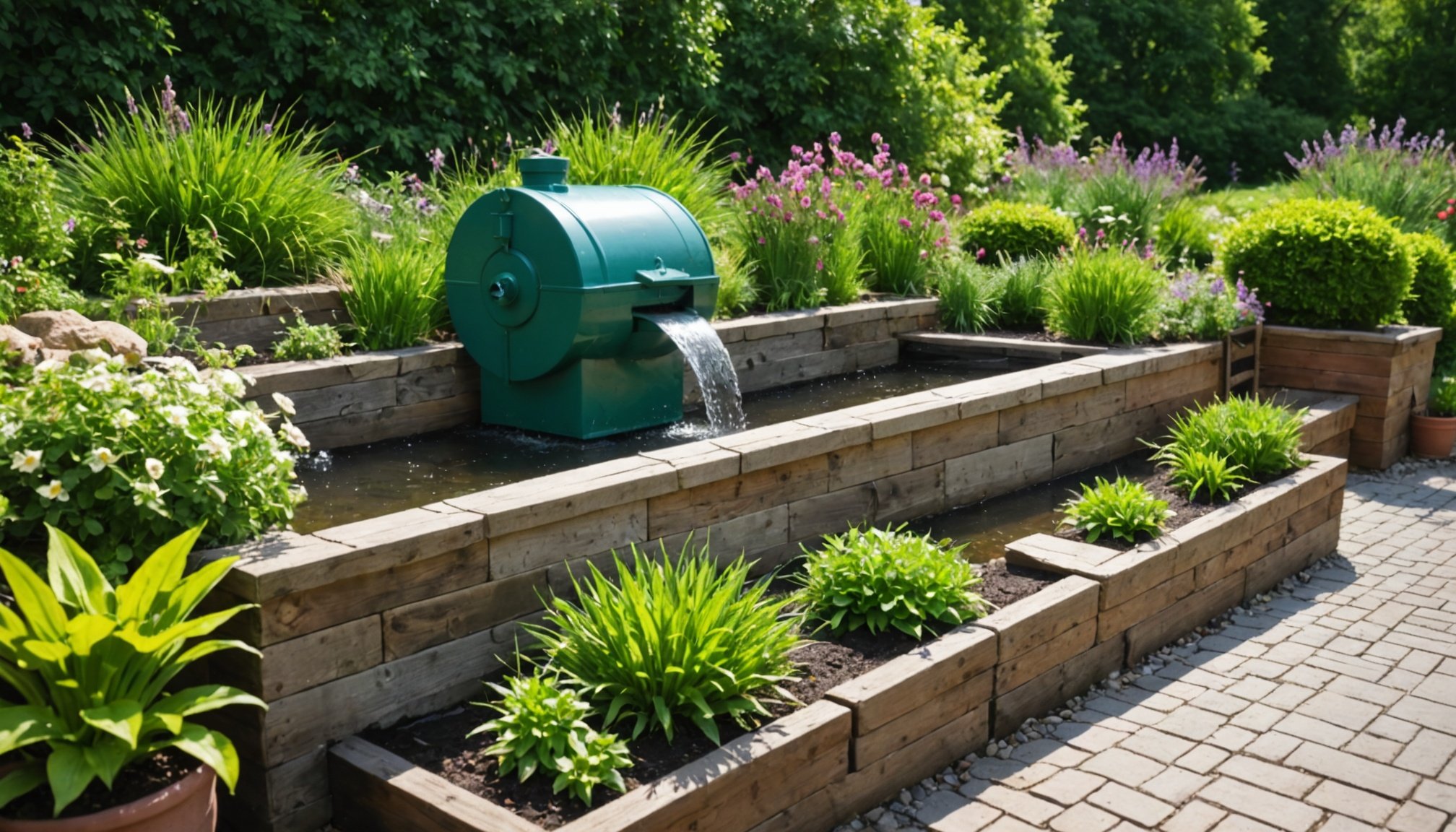Understanding Water Recycling in Gardening
Water recycling is crucial in gardening for maintaining sustainability practices. Not only does it ensure that gardens thrive, but it also conserves a precious resource. By utilising recycled water, gardeners contribute to the preservation of the environment and enhance the garden benefits.
There are several environmental benefits to recycling water in gardening. One significant impact is the reduction of strain on local ecosystems. By creatively reusing water, gardeners can lessen the demand on communal water supplies, which leads to healthier aquatic ecosystems and reduced disruption to wildlife. This practice is vital for areas suffering from water scarcity or droughts, as it contributes to the region’s health and stability.
Also to discover : Creating the Perfect Adjustable Lighting System for Your Home Art Studio: A Step-by-Step Guide
Aside from environmental benefits, there are also financial savings to consider. By employing water recycling strategies, gardeners can significantly reduce their water bills. Maximising the utility of each drop means less reliance on tap water, translating into direct savings over time. This financial incentive can make water recycling an appealing practice for economically minded individuals keen on sustainable living. By embracing water recycling, gardeners not only save money but also promote responsible and eco-friendly gardening practices.
Designing Your Water Recycling System
When designing garden water systems, key considerations revolve around aesthetic functionality and space efficiency. Water recycling systems should be seamlessly integrated into your garden’s landscape, ensuring that these design ideas not only enhance the environment but also contribute to sustainable practices.
In the same genre : Mastering Rooftop Gardening: Create a High-Performance Irrigation System for Your Vegetable Paradise
To achieve aesthetic integration, consider creative ideas that marry functionality with style. For instance, installing a rainwater catchment that doubles as a decorative feature, such as a sculptural fountain, can provide both practical water storage and visual appeal. Selecting materials and styles that harmonize with existing garden elements can make recycled water systems feel like a natural part of your outdoor space.
Thoughtful space planning is crucial. Space planning might involve placing water storage tanks in less prominent areas or camouflaging them with greenery. Alternatively, permeable landscaping with gravel or grass pavers can create pathways that direct rainwater to planting areas, optimizing both space and water usage.
In summary, the successful design of water recycling systems in gardens hinges on creative integration and efficient spatial layout, turning a practical necessity into a garden-enhancing feature.
Selecting Materials and Techniques
Selecting the right materials for water recycling is pivotal. There are several options when it comes to constructing water recycling features. For instance, materials such as polyethylene and stainless steel are often used for rain barrels, thanks to their durability and resistance to corrosion. These materials are excellent for environments exposed to weather elements.
Greywater systems, on the other hand, typically use PVC piping and filtration units made from polypropylene due to their ability to handle and purify household wastewater efficiently.
Comparing Water Recycling Techniques
Choosing between rain barrels and greywater systems requires consideration of best practices. Rain barrels are simple and economical, suitable for collecting roof runoff. In contrast, greywater systems are more complex but provide significant water savings by reusing water from showers, sinks, and laundries.
Sourcing Materials Locally
When sourcing materials, it’s advisable to opt for local and sustainable options. Local hardware stores often stock essentials while reducing carbon footprint. Seek out suppliers who offer recycled or sustainably-manufactured options to align with environment-friendly practices.
Implementation Steps for Your Water Recycling Feature
Implementing a water recycling feature requires careful planning and execution. Let’s explore a step-by-step process that will guide you through the installation seamlessly.
Begin by gathering the necessary tools such as a drill, pipe cutter, and wrenches. Safety equipment including gloves and goggles is also essential. Practical tips include reading the manufacturer’s manual thoroughly and marking all points where connections will be made.
The first step in the installation guide involves preparing the site and ensuring all piping is accessible. Next, connect the system’s pipes to the existing plumbing. Be sure to double-check seals and connections for leaks. Challenges such as tight spaces or misaligned pipes are common, but can be resolved using adjustable wrenches and flexible piping.
Once the setup is complete, conduct a test run. Monitor for any leaks or unusual noises. If issues arise, consult the troubleshooting section of the manual. Always follow safety protocols during the step-by-step process to avoid injuries. By taking these precautions, you can establish an efficient water recycling setup that enhances sustainability.
Maintaining Your Water Recycling System
Proper upkeep of your water recycling system is crucial to ensuring its efficiency and extending its lifespan. Here are some essential maintenance tips and best practices:
Regular check-ups can prevent costly repairs and ensure optimal system health. Inspect your system for any wear or damage every few months. Look for signs of potential issues such as leaks, unusual noises, or reduced water flow. Addressing these early can save time and money. If troubleshooting reveals more complex problems, it might be necessary to contact a professional.
Cleaning your system is an integral part of maintenance. Remove any debris or sediment from filters and tanks regularly. This not only prevents blockages but also keeps your system running smoothly. Utilize recommended cleaning agents that do not harm the water recycling features. For best results, establish a routine cleaning schedule.
Finally, remember that system longevity is heavily dependent on proper servicing. Regular servicing by a professional prevents significant issues and ensures all components are functioning correctly. With these practices, you can maximize efficiency and lifespan, enjoying the benefits of your water recycling system for years to come.
Enhancing Your Garden with Water Recycling
Garden enhancement can take on a new life when incorporating water recycling. By selecting water-efficient plants, you’re not only saving resources but also promoting biodiversity. This approach encourages various species to thrive, offering a balanced ecosystem within your garden. Selecting the right plants is crucial. For a garden that supports water recycling, consider introducing species like lavender, succulents, and native grasses, as they are known to flourish with minimal water.
Integrating water recycling not only aids in plant selection but also supports a variety of garden features. For instance, using recycled water in your garden can sustain ponds, ensuring they remain a vital habitat for aquatic life. Similarly, recycled water can drip through irrigation systems, nurturing your plants efficiently.
To maximize your garden’s health and biodiversity, embrace these recommended plants and techniques. Remember, a garden tailored with water recycling not only enriches the landscape but also contributes to a more sustainable future. Explore these options to create a haven of thriving biodiversity, supporting a myriad of life forms right in your backyard.
Resources and Further Inspiration
Embarking on a water recycling journey? You’re in good company! There is a plethora of online resources to aid your exploration. Websites dedicated to sustainable living offer comprehensive guides about water recycling, ranging from basic principles to advanced systems. For a more interactive approach, consider diving into the world of tutorials and videos available on platforms like YouTube. These resources provide visual guidance on the installation and maintenance of water recycling systems, making complex topics more accessible.
Feeling the need for a personal touch? Connect with local gardening communities. These communities are hubs of knowledge and enthusiasm, offering support and fresh ideas. Engaging with them could spark innovative solutions tailored to your specific needs. Whether you are a novice or a seasoned recycler, community support is invaluable for both inspiration and troubleshooting.
Remember, each additional resource you explore, every tutorial you follow, and each community connection you make enriches your water recycling experience, equipping you with the knowledge and confidence to make informed decisions.











